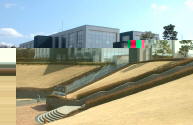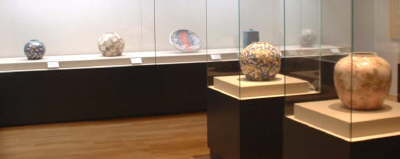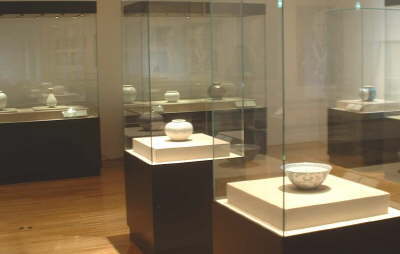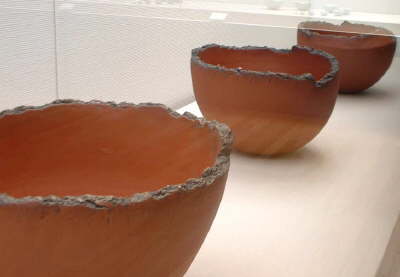|
Story by ROBERT YELLIN
for Daruma Magazine (#40, Fall 2003)
On this beautiful planet, full of joy and woe as I write, Japan has without doubt the largest number of art museums devoted solely to pottery-over 500 museums I've heard. That's a lot of beauty, or not, to take in.
Almost all major and minor potting centers, and some non-potting locales, have one museum either publicly or privately owned. Some museums are devoted to the collections of individuals, such as the splendid porcelain Toguri Collection in Shibuya, while others trace the history of the clay arts in a particular area, like the Okayama Prefecture Bizen Ceramic Museum (Japanese only). Some are potter's homes turned into museums, the splendid Kawai Kanjiro Memorial Museum in Kyoto (Japanese only) being a fine example. It's a must stop for anyone passing through Kyoto.
Until recently most such museums were focused on ancient wares -- meaning at least a few hundred years old -- or single potters, but as with everything these days, environments are rapidly changing. Museums have been built that highlight works made after the Meiji era. I'd like to introduce one called the Ibaraki Ceramic Art Museum.
Located in Kasama City, Ibaraki Prefecture, it opened in April, 2000, in the rolling hill park of Kasama Geijutsu no Mori (Kasama Art Forest). Kasama is also a style of pottery and the museum is the first prefectural museum in eastern Japan to focus on ceramics only. First though, a bit about the beginnings of this pottery as it is not well-known.
Kasama-yaki came into being during the Anei Era (1772-81). Kasama farmer-part-time potter Kuno Han'emon was visited by Shigaraki potter Choemon at Hakoda Village. Many Shigaraki potters back then traveled the country to show off their skills or simply find work. Soon after building a climbing kiln, Choemon went to work for the Korakuen kiln in Mito. After that Han'emon's adopted son Sehe'e received an introductory letter from Choemon to send to Shigaraki potter Kichisaburo, who in turn came to Hakoda and helped fire the kiln that Choemon had built. A bit complicated, but this is said to be the root of Kasama-yaki.
Many years later in 1853, the Kasama kiln-making and other techniques were passed on to form what may be the most famous of all Japanese ceramics outside Japan, Mashiko-yaki. Of course, this was almost 100 years before Mashiko's legendary Hamada Shoji (1894-1978) created pots there.
The output was basically utilitarian with large vats, room-heating hibachi, lidded jars and grinding bowls being the main goods sold from Hokkaido to Tokyo. Naturally enough, some jars had a flowing green glaze very similar to Shigaraki's Hagi-nagashi green copper glazed jars.
Yet with the advent of a "modern" lifestyle, these faced less demand; potters mostly created works for the table and a few for the tearoom -- Kasama has never been a noted tea style though. Near the museum are many ceramic shops showing the various styles that hundreds of Kasama potters create today. But what is Kasama-yaki these days?
When asked to give a clear definition, I don't think anyone can give a precise answer. Matsui Kosei (1927-), a Living National Treasure for neriage, and Wada Morihiro (1944-), a giant in contemporary Japanese pottery, both pot in Kasama for instance. What resemblance does their work have to traditional Kasama-yaki? None, OK, yet what is Kasama-yaki?
When I asked veteran Kasama potter Arata Koji Koji (1938-), he gave the same answer as me: "There is nothing that can really be called pure Kasama-yaki these days." A collector friend of mine put it this way:
Perhaps it has become more of a concept, an openness to change and innovation that provides the is-ness of whatever it is (much like Japan?).
I thought that summed it up nicely as change is a central factor for many aspects of what makes up Japan, particularly styles of pottery that must meet the needs of the day, or perish.
 The Ibaraki Ceramic Art is a large museum with high ceilings and many windows, which impart a spacious atmosphere. As one enters the main galleries though, the lighting becomes more subdued and accentuates the exhibits. For example, the permanent exhibition with representative works by Living National Treasure Ceramists is dim with a hushed glow from the glass cases. It has a fine large trailing slip bowl by Hamada Shoji (1894-1978), a magnificent large paddled jar by Karatsu's Nakazato Muan (1895-1985), and a fanciful covered ornamental jar with a hare design in overglaze enamels and gold by Kato Hajime (1900-1968). The museum has about 40 LNT (Living National Treasure) works, rotated twice a year. The Ibaraki Ceramic Art is a large museum with high ceilings and many windows, which impart a spacious atmosphere. As one enters the main galleries though, the lighting becomes more subdued and accentuates the exhibits. For example, the permanent exhibition with representative works by Living National Treasure Ceramists is dim with a hushed glow from the glass cases. It has a fine large trailing slip bowl by Hamada Shoji (1894-1978), a magnificent large paddled jar by Karatsu's Nakazato Muan (1895-1985), and a fanciful covered ornamental jar with a hare design in overglaze enamels and gold by Kato Hajime (1900-1968). The museum has about 40 LNT (Living National Treasure) works, rotated twice a year.
Two adjacent rooms are devoted to legendary Ibaraki potters Itaya Hazan (1872-1963) and Matsui Kosei. Matsui is an LNT for neriage, as mentioned above, and Hazan was among Japan's first studio potters to base his style on aristocratic Chinese wares. In a 2001 survey of the most influential Japanese ceramists of the 20th century by the ceramic journal Honoho Geijutsu, Itaya was tied for third with Kato Tokuro (1898-1985) and Kawai Kanjiro (1890-1966). The two before Itaya were Tomimoto Kenkichi (1886-1963) (also represented in the museum) and Yagi Kazuo (1918-1979) respectively. Itaya was born in Ibaraki Prefecture near Mt. Tsukuba, whence his art name Hazan ("wavy mountain"). Matsui, also a Buddhist priest, revitalized an old kiln at Gesshuji (月崇寺) Temple in Kasama. The kiln had been active ca. 1775-1945.

Matsui Kosei room
Designated an LNT in 1993, Matsui says of his work, "My colors are the first of their kind in the world. I think they are the colors of the future that many people will imitate in 50 years or so." Many of his exhibits are termed hariko-tsubo (jar) or hariko-kogo; the term refers to the transparent hard surface. Some pieces have intricately shaped petal-like designs that are indeed awash in a sea of color: soft emerald greens, Mediterranean blues or deep purples jump out at the viewer and are among his many ethereal colors.
Special Shows
Four times a year the museum hosts special exhibitions. When I visited in February 2003 I saw one of 25 contemporary master potters from western Japan. Now the term master here is relative, as we shall soon find out: I'm not sure the term potter entirely fits the glove either.
On display were 80 works ranging from the ornate, dazzling shell forms of Tomita Mikiko (1972-) to the large, bold sculptural forms of Hagi's Kaneta Masanao (1953-). Tomita was the youngest exhibitor and is garnering a name for herself with highly polished works based on old Banko ware.
In the bilingual catalog museum curator Todate Kazuko wrote of Tomita:
Tomita's works are intense to the smallest details and are almost "obsessive." They present us with worlds of tightly structured decorations which can be described as "Rococo motifs swallowed up by a Baroque setting" or a kind of "fusion of European and Islamic art" that could be observed in the streets of Portugal where Tomita spent her childhood years."
Indeed Tomita has presented a new facet to contemporary Japanese ceramics; I look forward to watching her develop even further as a ceramist.
It was a very eclectic and, in a way, bizarre show that included four anime-esque and outlandish yellow works by Hinoda Takashi (1968-): one visitor said Hinoda must have made them influenced by some mind-altering potion. They are indeed off the wall -- well, one actually hangs from a wall; intertwined limbs that looked more like a deformed hat rack. Get the picture. Truly strange, indeed asking the viewer "what exactly is ceramic art?" Only the individual can answer that. I find no redeeming value in it, unless I was a fan of anime or on a strange "trip."
The next gallery on the second floor had a science fiction landscape by Kyoto's Matsumoto Hideo (1951-). Other-worldly looking, like a backdrop from a sci-fi movie set. It was a rather long work (460 cm.) placed on the floor. It had the texture of ropy, fibrous washi paper and a cream cheese color.
Kawaguchi Jun's (1951-) porcelain spiral hung on the back wall, the only other piece in the darkly lit, dreamy room. Kawaguchi is one of Japan's more "colorful" artists and I mean that in a literal and figurative way. He attaches small bright-toned porcelain puzzle pieces such as triangles, tubes, buttons, circles and other ornaments onto a larger slab in casual randomness. Kawaguchi was recently appointed a Professor of Art at his alma mater-Kyoto Art University-where he studied ceramics with the "father of Japanese sculptural ceramics" -- Yagi Kazuo.
Miwa Kazuhiko's (1951-) spiked towers were also in the psychedelic sphere. Kazuhiko's father is Hagi's LNT Miwa Kyusetsu X (now known as Jusetsu) famous for his large white Oni-Hagi tea bowls. Kazuhiko does make traditional ware and many avant-garde works. He spent 1975 at the San Francisco Art Institute and the influence of his year abroad still shows strongly.
These art works were part of the "Decoration and Form Part 2" theme of the four-themed exhibition. The other three are:
- Decoration and Form Part 1
- Local Resources and Tradition
- Minimalism in Color and Form
More staid works, part of the minimalism section, were from white porcelain specialist Maeta Akihiro (1954-), the large and relaxed red jagged edged bowls of Imai Hyoe (1951-), and the refined silver and blue designs from Inoue Shinichi (1947-). Other works I admired were Yanagihara Mutsuo's (1934-) silver Oribe pieces and the bluish white porcelain plates and angled vessels of Yoshikawa Masamichi (1946-). As a side note, Yanagihara was just awarded the prestigious Japan Ceramic Society's Gold Prize. The JCS award went to Bizen potter Kaneshige Yuho.

Itaya Hazan room
Others in the Ibaraki exhibition were Imaiizumi Imaemon XlV (1962-), Kakurezaki Ryuichi (1950-), Kaneshige Kosuke (1943-), Takiguchi Kazuo (1953-), Tashima Etsuko (1959-), Toda Morinobu (1959-), Nakajima Hiroshi (1941-), Hayami Shiro (1927-), Fukushima Zenzo (1959-), Miwa Ryosaku (1940-), Mori Masahiro (1927 Morino Akito (1969-) and Taimei (1934-) and Yagi Akira (1955-).
I only foresee more interesting exhibitions at the Ibaraki Ceramic Art Museum, as curator Todate Kazuko is willing to take chances and explore the broader meaning of what it means to have a ceramic museum in Kasama. She takes it a step further to examine how it relates to the wide world of modern and contemporary Japanese ceramics.
Other rooms in the museum include a kenmin gallery (Citizen's Gallery) that is rented on a special basis. One is never really sure what will be shown there. The adjoining room traces the roots of Japanese ceramics on a wall map and some of Kasama's history. Strangely enough the room is the smallest gallery in the museum, displaying only three pots. And get this, only one is Kasama-yaki! The other two are from Shigaraki and Mashiko to show the connection and similarity of style.

Work by Imai Hyoe
The museum really isn't that far from Tokyo and a very pleasant day can be spent enjoying the provocative and subdued works on display, and then shopping for Kasama-made pots -- a short 70-minute train ride away from Ueno station on a Joban line express train to Tomobe Station.
The museum is located at 2345 Kasama. I took a free city bus there from Tomobe station and by car it's a 10-minute drive from the Kita-Kanto Expressway's Tomobe exit. Open from 9:30 am to 5:00 pm, 700-yen admission for adults, senior citizens enter free.
Robert Yellin runs an information cum learning center web site on Japanese pottery at www.e-yakimono.net and an online gallery and estore at www.japanesepottery.com.
LEARN MORE ABOUT KASAMA
LEARN MORE ABOUT IBARAKI'S CERAMIC SCENE
|